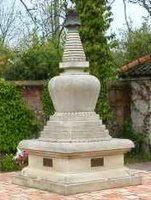A new stupa in Mexico
Following yesterday’s story from Australia, we zoom across the Pacific to the FWBO/AOBO Buddhist Sangha in Mexico, where they’re building a new stupa at Chintámani, their two-year-old retreat centre. Saddhajoti writes to say -
“Chintámani Retreat Centre, in Yautepec, Mexico, has now a new stupa. Two years after having been born, Chintámani is now up and running, housing retreats for our sangha (as well as for other groups) since October 2007.
“On the 9th of January, in the context of a women GFR retreat, Paramachitta, who is in charge of the women’s Ordination process in Mexico, conducted a moving ritual in which the stupa was dedicated to the Three Jewels.
“The symbolism behind the simple structure of a stupa is incredibly rich. Originally regarded as burial mounds, stupas became the first architectonic representations of the Buddha’s body sitting in the meditation. The base of the stupa represents the throne, his crossed legs the first step, his body the cubic structure in the middle, while his eyes are at the base of the cone over which rests the crown. A stupa also represents the correspondence between the five elements and the five spiritual qualities of the awakened mind. The cubic structure at the base represents the earth element, which symbolizes equanimity; the semi-sphere represents the element water which stands for the mirror-like wisdom; the cone represents the element fire which refers to compassion; above the cone lies a half moon representing the element air which symbolizes accomplished actions; and the little flame above the half moon is the element consciousness, which stands for the wisdom that sees Reality. In this way, the stupa is a tridimensional mandala.
“It is said that a stupa has the power to remove obstacles, promote peace and harmonize with the environment, which is why they were known as sacred mountains. From a Buddhist perspective, such sacred sites are not places to escape the world, but to enter it more deeply. The qualities they embody reveal the interconnectedness of all life and deepen awareness of hidden regions of mind and spirit. It was with this purpose in mind that the stupa at Chintámani was designed and constructed.
“Chintámani is run by Saddhajoti and Gisela, who started the project more than six years ago. At first it seemed a remote idea, but little by little the project took form and, with the generous participation of many members of our sangha, it has become a dream come true.
“It was recently the setting for the private ordination of Padmabandhu, and has housed several GFR retreats and Order weekends. We hope that Chintámani will keep on growing while offering people a quiet, relatively secluded, and inspiring spot in which to deepen their meditation and Dharma practice, as well as functioning as a context for sangha building.
“Thus, we hope that the blessing and dedication of the new stupa will help all who visit it to awaken within themselves its qualities and energies, which ultimately lie within our minds, and to discover the inner realms within which our own deepest nature lies hidden.
“If you look closely at the photos you will see that the stupa is not finished yet. It still needs it´s crown or pinnacle. But it already looks like a proper stupa, doesn´t it?”
Chintámani Retreat Centre is online at www.retirosenmexico.com
Sadhu Chintámani!


 rss
rss